Arm Announces Mobile Armv9 CPU Microarchitectures: Cortex-X2, Cortex-A710 & Cortex-A510
by Andrei Frumusanu on May 25, 2021 9:00 AM EST- Posted in
- SoCs
- CPUs
- Arm
- Smartphones
- Mobile
- Cortex
- ARMv9
- Cortex-X2
- Cortex-A710
- Cortex-A510
New DSU-110 L3 & Cluster: Massively More Bandwidth
Alongside the new CPU microarchitectures, Arm today is also announcing a new L3 design in the form of the new DSU-110. The “DynamIQ Shared Unit” had been the company’s go-to cluster and “core complex” block ever since it was introduced in 2017 with the Cortex-A75 and Cortex-A55. While we’ve seen small iterative improvements, today’s DSU-110 marks a major change in how the DSU operates and how it promises to scale up in cache size and bandwidth.
The new DSU-110 is a ground-up redesign with an emphasis on more bandwidth and more power efficiency. It continues to be the core building block for all of Arm’s mobile and lower tier market segments.
A key metric is of course the increase of L3 cache configuration which will now go up to 16MB this generation. This is of course the high-end of the spectrum and generally we shouldn’t expect such a configuration in a mobile SoC soon, but Arm has had several slides depicting larger form-factor implementations using such a larger design housing up to 8 Cortex-X2 cores. This is undoubtedly extremely interesting for a higher-performance laptop use-case.
The bandwidth increase of the new design is also significant, and applies from single-thread to multi-threaded scenarios. The new DSU-110 promises aggregate bandwidth increases of up to 5x compared to the contemporary design. More interesting is the fact that it also significantly boosts single-core bandwidth, and Arm here actually notes that the new DSU can actually support more bandwidth than what’s actually capable of the new core microarchitectures for the time being.
Arm never really disclosed the internal topology of the previous generation DSU, but remarks that with the DSU-110 the company has shifted over to a bi-directional dual-ring transport topology, each with four ring-stops, and now supporting up to 8 cache slices. The dual-ring structure is used to reduce the latencies and hops between ring-stops and in shorten the paths between the cache slices and cores. Arm notes that they’ve tried to retain the same lower access latencies as on the current generation DSU (cache size increases aside), so we should be seeing very similar average latencies between the two generations.
Parallel access increases for bandwidth as well as more outstanding transactions seem to have been also very important in order to improve performance, which seems very exciting for upcoming SoC designs, but also puts into more question the previously presented CPU IPC improvements and exactly how much the new DSU-110 contributes to those numbers.
Architecturally, one important change to the capabilities of the DSU-110 is support for MTE tags, a upcoming security and debugging feature promising to greatly help with memory safety issues.
The new DSU can scale up to 4x AMBA CHI ports, meaning we’ll have up to 1024-bit total bi-directional bandwidth to the system memory. With a theoretical DSU clock of around 2GHz this would enable bandwidth of up to 256GB/s reads or writes, or double that when combined, plenty enough to be able to saturate also eventual high-end laptop configurations.
In terms of power efficiency, the new DSU offers more options for low-power operation when in idle situations, implementing partial L3 power-down, able to reduce leakage power of up to 75% compared to the current DSU.
In general idle situations but still having the full L3 powered on, the new design promises up to 25% reduction in leakage power all whilst offering 2x the bandwidth capabilities.
It’s important to note that we’re talking about leakage power here- active dynamic power is expected to generally scale linearly with the bandwidth increase of the new design, meaning 5x the bandwidth would also cost 5x the power. This would be an important factor to note into system power and in general the expected power behaviour of the next-gen SoCs when they’re put under heavy memory workloads.
Arm describes the DSU-110 as the backbone of the Armv9 cluster and that seemingly seems to be an apt description. The new bandwidth capabilities are sure to help out both with single-threaded, but also with multi-threaded performance of upcoming SoCs. Generally, the new 16MB L3 capability, while it’s possible somebody might do a high-end laptop SoC configuration, isn’t as exciting as the now finally expected move to a new 8MB L3 on mobile SoCs, hopefully also enabling higher power efficiency and more battery life for devices.


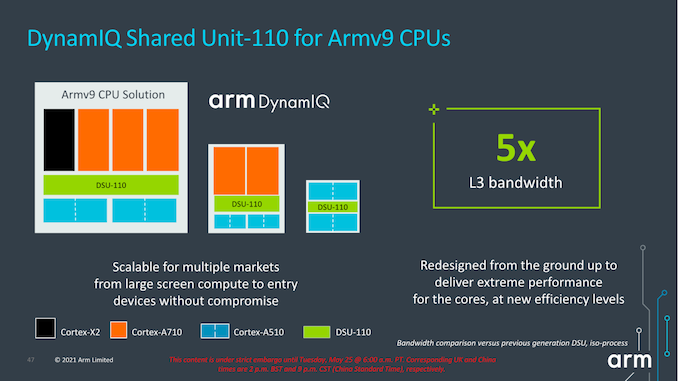
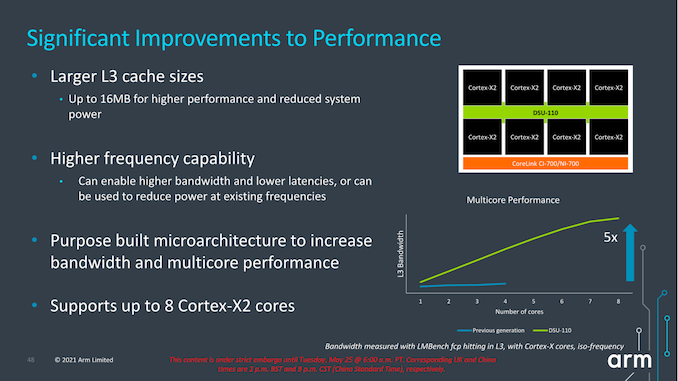
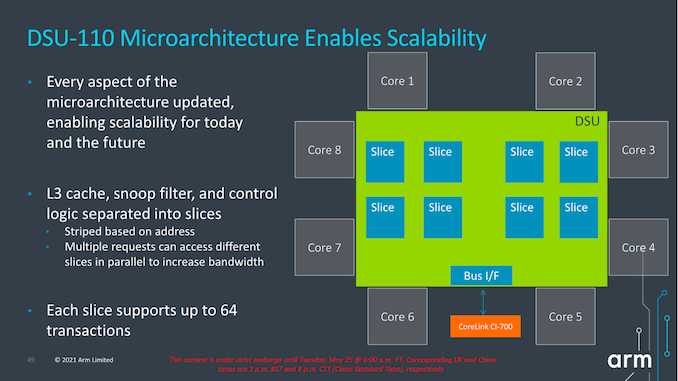
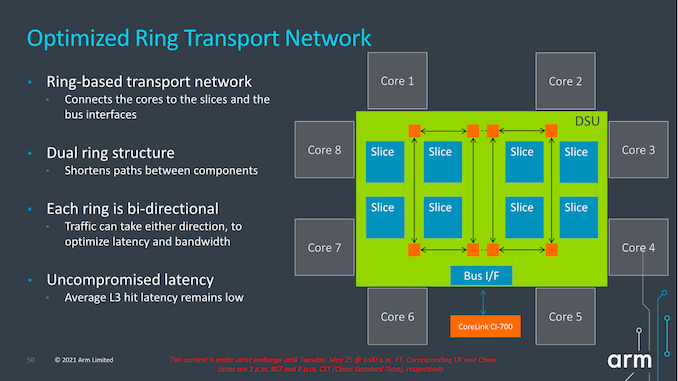
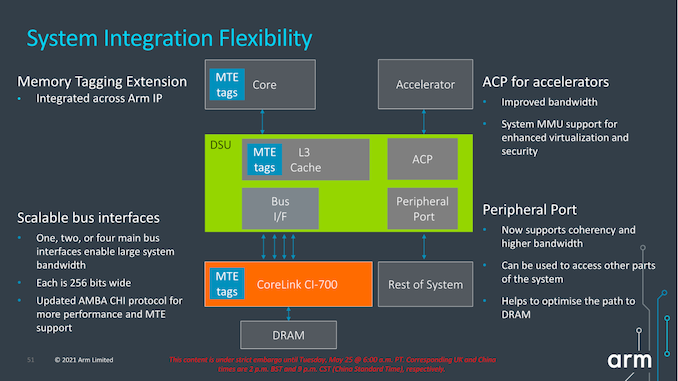

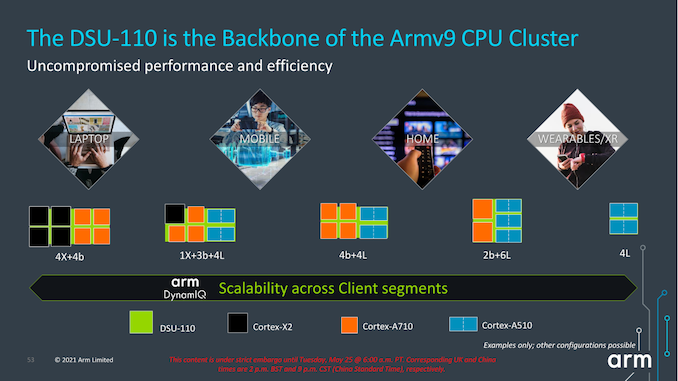








181 Comments
View All Comments
Spunjji - Thursday, May 27, 2021 - link
Comments saying "x86 is dead" are just as daft as the comments declaring that ARM will never be a threat to x86.mode_13h - Tuesday, May 25, 2021 - link
What a terrible naming scheme!If they didn't want to just start from a blank slate, they should've gone on to letters. So, A7A and A5A.
Also, given that the X-cores are typically going to be paired with their cousin A-series core, the naming scheme should reflect that relationship. So, maybe the X1 should've been the X78 and the X2 could be the X710 or X7A.
mode_13h - Tuesday, May 25, 2021 - link
Also, why skip 9? A59 and A79 would be a great mnemonic for the first mobile cores to be ARMv9!nandnandnand - Tuesday, May 25, 2021 - link
I'm fine with the naming scheme.For the Cortex-X line, they can just do X1, X2, X3, X4... X-cetera.
For these new ones, A710 and A510 are the baseline, and they can put out A720, A525, or whatever until they run it up to A799. That could take over a decade if they don't increment the numbers so much. The '7' and '5' let you know these are related to the A78/A55, and the 3 digits lets you know it's part of the brave new world of ARMv9.
mode_13h - Tuesday, May 25, 2021 - link
> they can put out A720That could potentially create some confusion about the relationship between A72 and A720.
> 3 digits lets you know it's part of the brave new world of ARMv9.
Okay, so create a new numbering scheme! No need to piggy back off the old one, if it's "a brave new world", right?
phoenix_rizzen - Tuesday, May 25, 2021 - link
Would have been a good time to pick new letters. Leave Cortex-A, Cortex-X, Cortex-M etc for Armv8.x.Even better, drop the Cortex name, and pick something new for Armv9-based cores.
X, Y, Z would have been nice for big, middle, little cores.
Ah well, marketing-droids will do what marketing-droids do. :D
mode_13h - Tuesday, May 25, 2021 - link
Also, A79 would line up nicely with being the last generation of this microarchitecture family.Then, maybe the "Sophia" cores could start a new numbering series.
GeoffreyA - Thursday, May 27, 2021 - link
"What a terrible naming scheme!"They should battle it out with Intel's Marketing arm to see who's the best in the field of naming.
eastcoast_pete - Tuesday, May 25, 2021 - link
Disappointed in the design choice of the new LITTLE cores. I have the strong suspicion that the IPC comparison of the 510 LITTLE core to the A73 (the 510 getting close to the A73) is with one 510 core per complex, maximal cache and cache bandwidth etc, which, of course, is highly theoretical. After all, the 510s are designed to come in pairs sharing resources for a reason. I am underwhelmed by this design, ARM's own power/perf curves show very little if any difference to A55 until one gets to the high end of the power curve, at which point the 710 big cores would have taken over. Unfortunately, Apple's power/perf crown for efficiency cores remains quite and comfortably safe. As an Android user, however, I remain stuck with ARM's designs, as none of the design houses (QC, Samsung) is even attempting custom core designs for smartphone SoCs. We are seeing the downside of a monopoly heremode_13h - Tuesday, May 25, 2021 - link
> I remain stuck with ARM's designs, as none of the design houses (QC, Samsung)> is even attempting custom core designs for smartphone SoCs.
Qualcomm is saying they're using their Nuvia acquisition to make new mobile cores.